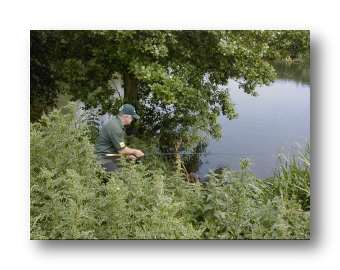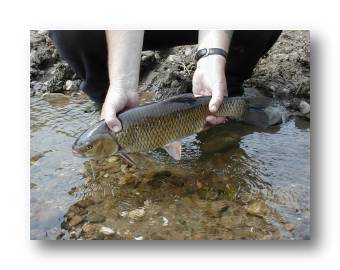As I write, sitting at my window in the closed season, I see that yet another weather system comes rolling in from the Atlantic. With the rain and wind combining to produce a thoroughly miserable day, my thoughts turn toward next summer and in particular, those fat summer chub which inhabit the lower reaches of my local river, the River Test in Hampshire.
Apart from seeing the odd trout and salmon angler, these chub won’t have been disturbed during the close season and although having recently spawned, they will nevertheless soon start to pack on the weight and provide a challenge for the angler. 
My favourite method involves stalking the chub and with the water being so very clear during the height of the summer, spotting the fish is usually quite easy; catching them however, is another matter.
One of my favourite stretches involves a walk of half a mile or so downstream to where a tributary meets the main river.
Arriving at daybreak with just a rucksack, rod, reel and landing net, I follow the river down. Apart from being a good time to catch chub, fishing at the start of a new day is so therapeutic, as it is so calm and peaceful with nobody else about to disturb matters. I walk along quietly and carefully, but a little way back from the water’s edge.
This allows me to see where the fish are, and a mental note is taken so that I can catch them unawares later in the day, this time approaching them from downstream.
As most anglers know, chub aren’t usually very fussy about which bait you use and every angler will have his own favourite. Unfortunately for me, worm, maggot and caster are not allowed to be used on this part of the river and most anglers would consider this to be a disadvantage. This I have tried to turn to my advantage by using baits that previously I had never used.
It’s all too easy to use maggot, caster or worm and all are excellent baits but, be honest, when was the last time you went to your local water without any of them?
Bread, sweetcorn, luncheon meat and paste baits are my most used baits during the fishing season but for freelining I prefer to use slugs.
I have to say here and now that I detest the things but that is where the chub and I agree to differ, the chub sometimes racing to intercept the bait before I’ve had time to close the bail arm. Kept in a baitbox amongst some damp lettuce leaves, these succulent baits have accounted for many of my summer chub.
A few pointers though, especially to those who have never tried slug before: Don’t be afraid to use the largest slugs that you find, chub have big mouths. Always match your hook size to the size of the bait, even if it means using a size four or size two. Finally one word of warning, always keep your slugs in the shade, if they get too hot you’ll end up with slug soup in your baitbox!
Anyway, back to the matter in hand. After my walk downstream, I’ll make a quick brew of tea, tackling up whilst the kettle comes to the boil. The chub go to over 6lb here so I use 6lb line straight through to the size 4 hook, the slug being hooked once through the head but with the hook point showing.No shot are needed because the slug provides enough weight to be cast easily.
I already know roughly where the fish are so I’ll slowly work my way upstream, taking just the essentials and a set of scales in my waistcoat pocket. Also, I’m wearing a quality pair of polarising glasses as well as a wide-brimmed hat to help reduce glare and makes fish spotting easier.
Stealth is the keyword here, so I tread lightly and keep my eyes peeled.After a couple of minutes and having crept only a few yards, a pair of chub are spotted just below the surface. Nothing big, but around 3lb apiece and worthy of a cast.
A slug is selected from the bait box and once hooked, I slowly manoeuvre myself into a casting position. A short flick upstream and the bait lands, with an audible ‘plop’, a yard above where the chub are stationed.
Now, providing that the fish are unaware of your presence, there is little to stop the chub from taking the bait, this time, however, both fish bolt and head toward the far bank where a bush overhangs the water.
This sort of thing happens once in a while. Maybe the chub saw something that frightened them, such as a flash from the rod whilst I was making my cast. It’s all part and parcel of this stalking game I’m afraid, and you’ll have to learn to accept that this sort of thing happens, even to the best of us.
I continue working my way upstream and locate another chub, this time lying behind a bed of streamer weed.
Once again I cast my slug but it falls short, I’m just about to wind in and recast when the fish turns and grabs the bait, the line draws tight and I pull the hook home with a firm strike. Immediately the fish is in the streamer roots and I have to apply maximum pressure before it yields. The fish then charges downstream in an attempt to evade capture, but with careful playing he’s soon netted.
Amazingly, the hook drops out as I lift the fish from the net, I don’t bother to weigh him but estimate the weight at about 4lbs – a nice fish to start the day.
After checking the hookpoint, which appears to be OK, my journey continues.Already the heat of the sun is noticeable on my back and with not even the slightest breeze, I just know that it’s going to be another scorcher today.
Conditions like these can be difficult for the angler, but to those who persevere, the rewards can be great. Two years ago my best chub, a plump fish of 5lb 3oz, fell to a freelined meatball when the sky was clear and the temperature rising. 
My next fish is from a swim that I know well. Getting to it involves a little bit of jungle warfare, having to hack my way through chest high stinging nettles, but there are always chub here.
Upstream of the swim is relatively shallow, but a semi-submerged tree that fell during a storm has forced the current to scour a deep hole in the riverbed.This has left a nice slack spot right under my own bank and the only way to reach the chub undetected is to crawl slowly to the water’s edge.
Once in position I can see six or seven chub just under the surface. The largest, a fish of around 5lbs, is surrounded by the smaller fish.Of course, I want the biggie to take my bait rather than one of the others so accurate casting is required.
Thankfully, my cast lands right on the nose of the big one. Ever so lazily it sucks in my offering, the line twitches as I watch the chub chomping away and I strike. The water erupts as all the fish scurry away towards the far bank. All the fish except mine that is.
My fish goes deep and hugs the bottom. The rod soaks up the powerful lunges as the chub desperately tries to reach the submerged tree roots.Thank heavens I’m using 6lb line I think to myself, as both the rod and clutch work together to subdue it. Eventually, I sink the net and draw the fish over the rim. He’s mine. The hook is right at the back of its mouth but it’s soon removed with the forceps.
I stare at my prize and wonder at its beauty for a few seconds as I fumble to remove the scales from the pocket of my waistcoat.
The landing-net handle is detached and I weigh the fish in the net, the pointer zipping past the 5lb mark and then settling at 5lb 14oz. I wet my hands before gently slipping him back into the water. Content now, The tackle is gathered and order is restored.
The Kelly kettle is fired up once more and I am just happy to sit and wait for it to boil.
Oh, silly me I nearly forgot: The net weighed 15 ounces!










